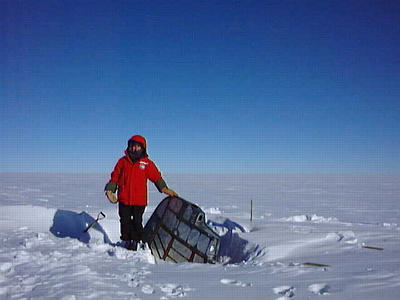20 January, 1999
Wednesday, January 20th, 1999, South Pole Station.
Greetings to everyone from the South Pole! The temperature was still
around minus 22 degrees of Celsius, but the wind was picking up today.
Wake up at 7:15 to be ready at 8:30 A.M. for a meeting at the BIF. We
were discussing the winter-launch procedure which Andy and Joel were
supposed to use during the Antarctic winter. The latex balloons used
in the summer would become brittle at temperatures of -85 to -90
degrees of Celsius. The winter balloons are made out of plastic, are
much larger, but durable at such temperatures. I was looking forward
seeing this procedure. Today, we conditioned an ozonesonde model (2Z)
for the plastic balloon launching. A different company makes this
ozone model, which I introduced already earlier. It requires a few
different preparatory steps, which Bryan reviewed with us.
During the rest of the day, I was working on the data files and
answered more email questions. These are great questions!! Thank you.
What about my questions: what is a knot and why did I walk on ancient
snow? A knot is used at sea to describe the speed of wind or a ship.
Why is it used in the Antarctic at the South Pole with no water
around? Since members of the Navy were the first to establish a
station here in the Antarctic, a lot of vocabulary remained. (Using
galley for cafeteria is one of them.) A knot describes how many
nautical miles a ship can cover per hour. The North - South distance
on our globe is measured in minutes of latitude. One minute latitude
equals one nautical mile. There are 60 minutes per degree. Lets see
---- New York is at about 43 degrees North --- adding the 90 degrees
from the equator to the South Pole (we are at 90 degrees South)
results to 133 degrees times 60 minutes = 7980 nautical miles times
1.15 (land mile) equals to 9 390 miles. That is how far I am from New
York or any other city at that latitude. The wind was about 8 knots
today; what would that be in miles per hour?
Why do I walk on ancient snow here at the South Pole? The snow has
accumulated over thousand of years to a height of about 9300 feet.
Scientist who study glaciers and climate take advantage of this fact
and take ice cores to 'look back in history' by studying the
composition of cores. Fascinating! Another interesting fact is that we
are actually at a physiological altitude of 10300 feet. How do we
calculate the physiological altitude? I will find out.
Today's Wednesday night lecture was about the new South Pole Station.
The construction started three years ago. The science habitat will be
all above surface so that snowdrift will not cover the station again
like it did with the first and the present station. I would live to
come back in a few years and see the new construction.
10 pm., after the lecture, Bryan and I went for another exploration on
skies to visit on old plane about 1 hr ½ from the station away. We air
was phantastic again except the wind had increased to 12 knots. It was
more difficult coming home against the wind. But challenging. I was
fast asleep by 2 a.m.

I am at the old plane, about 2 miles outside the station. The plane is covered with drift snow. We were able to look inside. Nobody was hurt when the plane landed outside the run-ways somtime in the 70ties.
Contact the TEA in the field at
.
If you cannot connect through your browser, copy the
TEA's e-mail address in the "To:" line of
your favorite e-mail package.
|
